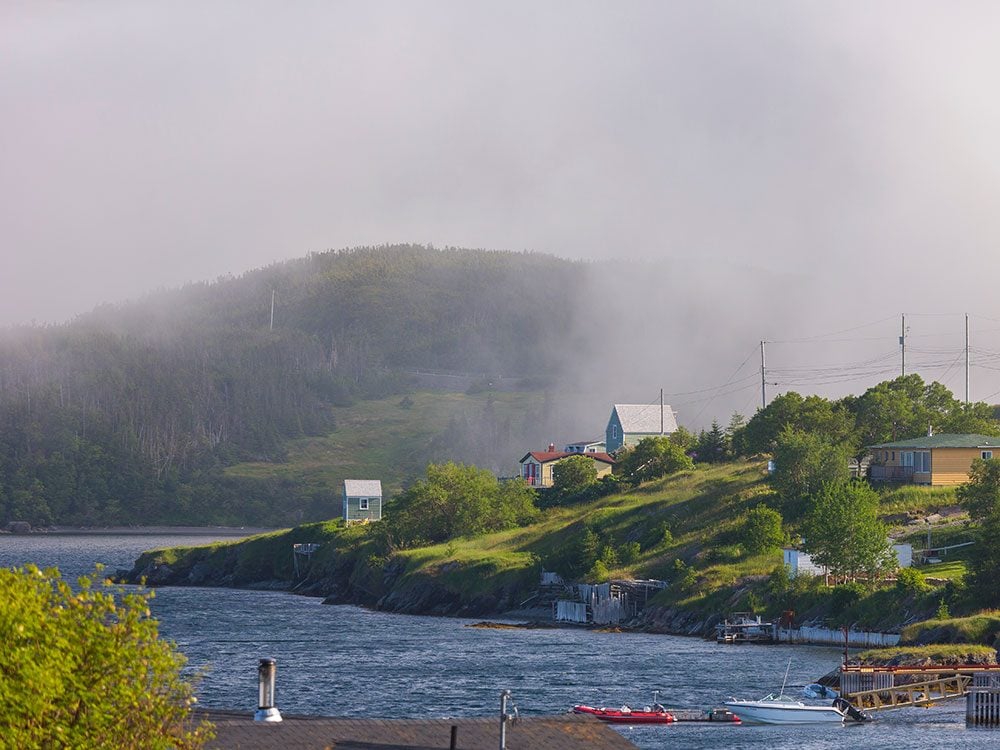
Words You’ll Only Hear in Newfoundland
It’s nearing the spring equinox, and Ryan Snoddon, CBC’s meteorologist in Newfoundland and Labrador, calls for a change in the weather. “Let’s hope this is Sheila,” he says during an early morning webcast. He’s referencing St. Patrick’s wife, who, according to local folklore, is responsible for administering the final brush of snow across the land before spring. It might be an overly optimistic forecast in this storm-battered corner of the North Atlantic, but Snoddon can be certain of one thing: his viewers, who are familiar with the language of Newfoundland, will understand this piece of regional lingo. It’s one of thousands of terms employed only in Canada’s easternmost province, where language and landscape are deeply intertwined.
The cache of words used to describe Newfoundland and Labrador’s natural environment is as vast and wide as the province itself—and, like most of life lived along the coast, weather dependent.
Known as “the Rock” for its jagged coastlines and impenetrable soil, the island of Newfoundland and its mainland counterpart, Labrador, were the first North American stops for European peoples, whose histories and vocabularies intertwined in this remote new world. Meanwhile, the Indigenous people—Inuit and Innu in Labrador, Mi’kmaq in west and central Newfoundland—had their own rich languages from which the newcomers occasionally borrowed.
European settlement began with the arrival of explorer John Cabot, who reached the island of Newfoundland in 1497 and claimed it for England. Cabot returned home with astonishing tales about the abundance of cod. The waters were so thick with fish, the mythology goes, that you could walk across their backs to the shore.
Drawn by the aquatic bounty, the Basques, French, Spanish, Portuguese, Irish and West Country English followed, fishing the waters that surrounded the island and Labrador. What were initially seasonal fishing stations transformed into permanent communities—called outports—by the late 18th century. The tiny settlements ringed the shoreline and were connected only by the sea.
The language of Newfoundland bloomed in this isolation, inspired by the wild environment and influenced by Old World cultures. Words arrived from everywhere. Spanish fishermen brought “bacalao,” their name for cod. “Dwy,” which described a short, sudden storm, came from West Country English. A local trickster was called a “sleveen,” an expression adopted from Irish. Newcomers also picked up on terms already tied to the place, like “tabanask,” an Innu-aimun term for toboggan, and “sina,” the Inuktitut word used to describe the edge of a floating ice field.
But sina wasn’t enough; there were so many types of ice and snow in the coastal waters. Naming these unfamiliar formations—the soft ice close to shore (“lolly”), or a mass of ice and snow in seawater (“slob”)—was paramount to fishermen’s survival. (Smaller boats could navigate through lolly ice, but slob ice could be impassable for even the larger sealing vessels, trapping them offshore.)

“Mauzy,” “Fairy Squalls” and “Glitter” — A Newfoundlander’s Guide to Weather
Because of this, the language of Newfoundland was often occupational and rooted in the culture of the fishery. For a weather forecaster like Snoddon, language is similarly tied to vocation. He regularly peppers his forecasts with local terms. Overcast, damp and foggy days are “mauzy,” and he constantly calls for “RDF,” the regional acronym used for rain, drizzle and fog. So far, he hasn’t managed to use “glitter”—the term for freezing rain that builds up as ice on branches and wires—or “fairy squall,” a sudden gust of wind that seems to come from nowhere, as if conjured by supernatural forces. As a transplant from Ontario, Snoddon carefully learns the vernacular, so he can integrate it in a way that seems natural.
“You want to get your street cred before you try to use those kinds of words,” he says. “You don’t want to make it just seem like you’re saying them for the sake of saying them.”
Why Newfoundland and Labrador has its own lexicon, and why so many of the province’s words relate to the coastal environment, is both obvious and complex, says folklorist Philip Hiscock of Memorial University.
The further people were from the authoritative culture of St. John’s, the province’s capital—and, by extension, the further they were from Britain and Canada—the less it mattered, so dialect varies from region to region. “Words that are important to you are those that reflect right here and now,” says Hiscock. “So they’re going to change, and they’re going to be imbued with a sense of locality.”
Another factor in the development of these distinct dialects is Newfoundland and Labrador’s strong oral tradition. Storytelling flourished in the isolated outports, where talk and song were the primary forms of entertainment. Tales were often born of hardship, adversity and perseverance in the face of poverty. These narratives were inspired by a world that was both harsh and beautiful, good and bad—the dichotomy at the heart of all great tales. Then, as now, stories were told with attention to language. Perhaps there simply weren’t enough words to describe the erratic weather and rock-lashed land. Maybe the language of Newfoundland was not simply the result of limitation—the isolation of the outports—but a response to the limitlessness of the natural and social landscape.
Is Newfoundland on your bucket list? Check out 10 essential experiences on the east coast of Canada.

The Dictionary of Newfoundland English
Efforts to preserve the language of Newfoundland are underway, from the “b’ys” (read: dudes) on George Street in St. John’s outdoing one another with local slang to the academics who collect and study this kind of talk like capturing a specimen in a jar.
The best-known and most prolific collection of the province’s words is the Dictionary of Newfoundland English (DNE). Produced by a trio of scholars and based out of Memorial University, it was published in the early 1980s after more than two decades of research.
The aim of the 770-page book was to create a storehouse from which scholars and, perhaps more importantly, Newfoundlanders from all backgrounds could draw. The creators have largely achieved their goals; the DNE can be found on living-room coffee tables from Muddy Hole to Joe Batt’s Arm. It has been reprinted 17 times since it was first published.
The dictionary defines each word and includes spelling variants, but also offers insight into the culture, culling from both oral and written sources and including snippets of these texts to illustrate how the language of Newfoundland might be used in a casual conversation.
This is helpful for the layperson, as many of the words in the DNE are no longer in popular use and others are regional. Along the southern coast of Labrador, for example, a “floater” is a migratory fisherman. He could also be called a “roomer,” as he sets up a seasonal fishing room to work from. But a room might also be referred to as a “station,” and so the roomer or floater might also be a “stationer,” depending on which community you’re from.
Words like roomer, floater and stationer have largely disappeared from the vocabulary as technology has progressed and the economy has changed. When the fishery moved from an inshore, family-based industry to commercial fleets, there were no longer “beachmasters” (the person responsible for curing and drying fish) or “dressers” (the person who removes the backbone, head and guts).
Meanwhile, climate change may increase the occurrence of ice storms, so words like silver thaw and glitter could enjoy a resurgence.
When the DNE editors began compiling the tome in the 1950s, they saw joining Confederation as one of the main threats to the language of Newfoundland. Then-premier Joey Smallwood famously said he would drag Newfoundland kicking and screaming into the 20th century, suggesting that the region was heavily rooted in the past. A secondary menace: people who felt regional words were outdated, marking Newfoundlanders as inferior, and not worthy of preservation. The distasteful “Newfie” jokes, which mimicked the island’s dialect and cast inhabitants as hapless goofs are, thankfully, dying out in the rest of Canada, where they were once popular.
Don’t miss this heartwarming story that convinced one family that Newfoundland is the kindest province.

The Resurgence of “Newfoundlandese”
Across the province, speakers are repurposing the language as a way of asserting their roots. Along with his uniform, a tour guide might slip on an Irish-sounding brogue and sprinkle his speech with Newfoundlandese while performing for tourists, or it might be a routine adopted among peers, proving your insider status by using words like “touton” (a traditional food of deep-fried bread with syrup) or calling mosquitos “nippers.” Terms like these function as a linguistic secret handshake.
Still, the language revival is small-scale. Some words will persist and others will remain a historical mark, an entry in the DNE.
“You can’t really save a language, but you can renovate it,” Hiscock says. “It’s a little like tearing down an old building and saving the wood and the windows so that other people can put it to use in their places.”
As the fishery continues to decline and some of the language goes with it, words are being used in new ways. They appear in visual art, music and literature; in the names of businesses, restaurants and cultural ventures across the province; and, of course, in the daily weather forecast.
There’s one word Snoddon admires above all others and hopes to incorporate into his newscasts: screecher. It’s used to describe a howling wind or storm. “I’ve been thinking, Could I pull it off?” Snoddon asks. Then he dons his newscaster voice and tries it out: “There’s a real screecher of a wind out there today.” He’s silent for a beat. “I wonder, how many people would really know what I was talking about?”
When storm season approaches, Snoddon will have plenty of occasions to try it out. Maybe he’ll be responsible for bringing screecher back into the local lexicon, putting his own twist on the word, claiming it, and in doing so, setting it free.
Next, learn to decode these common Newfoundland sayings.
© 2015, by Emily Urquhart. From “The Unique Language of Newfoundland,” hakaimagazine.com (December 2, 2015).